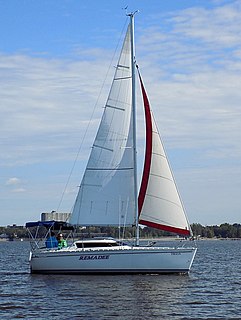Related Research Articles

The Tonic 23 is a French trailerable sailboat, that was designed by Philippe Harlé as a coastal cruiser and first built in 1985.
The Balboa 16 is an American trailerable sailboat that was designed by W. Shad Turner as a day sailer and first built in 1981.
The Balboa 24 is an American trailerable sailboat that was designed by W. Shad Turner and William Downing as a racer-cruiser and first built in 1981.
The Antrim 20 is an American trailerable sailboat that was designed by Jim Antrim as a cruiser and first built in 1982.
The Aquarius 23 is an American trailerable sailboat that was designed by Peter Barrett and Stan Miller as a cruiser and first built in 1969.
The Aquarius 21 is an American trailerable sailboat that was designed by Peter Barrett as a cruiser and first built in 1969.
The Balboa 22 is an American trailerable sailboat that was designed by W. Shad Turner and William M. Downing as a cruiser and first built in 1977.
The Cal 21 is an American trailerable sailboat that was designed by C. William Lapworth as a cruiser and first built in 1969.
The Ensenada 20 is an American trailerable sailboat that was designed by Lyle C. Hess as a cruiser and first built in 1972.

The Holder 20 is an American trailerable planing sailboat that was designed by Ron Holder, in collaboration with sailmaker Dave Ulmann, as a one design racer and first built in 1980.
The La Paz 25 is an American trailerable sailboat that was designed by Lyle C. Hess as a motorsailer and first built in 1973.
The Montego 19 is an American trailerable sailboat that was designed by Johannes "Jopie" Helsen as a pocket cruiser and first built in 1976.
The Montgomery 17 is an American trailerable sailboat that was designed by Lyle Hess as a pocket cruiser and daysailer and first built in 1973.
The Montgomery 23 is an American trailerable sailboat that was designed by Lyle Hess as a cruiser and first built in 1979.
The RK 20 is an American trailerable sailboat that was designed by Lyle C. Hess as a cruiser and first built in 1972.
Coastal Recreation, Inc was an American boat builder based in Costa Mesa, California. The company specialized in the design and manufacture of fiberglass sailboats designed by well-known naval architects, including Lyle C. Hess, Peter Barrett and W. Shad Turner.
The Balboa 26 is an American trailerable sailboat that was designed by Lyle C. Hess as cruiser and first built in 1969.
The Balboa 27 8.2 is an American trailerable sailboat that was designed by Lyle C. Hess as a cruiser and first built in 1976.
The Venture 22 is an American trailerable sailboat that was designed by Roger MacGregor as a cruiser and first built in 1968.
The Windrose 22 and Laguna 22 are a series of American trailerable sailboats that were designed by W. Shad Turner as cruisers and first built in 1977.
References
- 1 2 3 4 5 6 7 McArthur, Bruce (2020). "Balboa 20 sailboat". sailboatdata.com. Archived from the original on 8 January 2021. Retrieved 8 January 2021.
- 1 2 McArthur, Bruce (2020). "Lyle C. Hess 1912 - 2002". sailboatdata.com. Archived from the original on 7 January 2021. Retrieved 8 January 2021.
- 1 2 3 4 5 6 7 8 9 Henkel, Steve: The Sailor's Book of Small Cruising Sailboats, page 84. International Marine/McGraw-Hill, 2010. ISBN 978-0-07-163652-0
- 1 2 3 Malseed, Chuck (January 1977). "Lyle Hess: A Profile". Cruising World. Retrieved 8 January 2021.
- ↑ McArthur, Bruce (2020). "Ensenada 20". sailboatdata.com. Archived from the original on 8 January 2021. Retrieved 8 January 2021.
- ↑ McArthur, Bruce (2020). "RK 20". sailboatdata.com. Archived from the original on 8 January 2021. Retrieved 8 January 2021.
- ↑ McArthur, Bruce (2020). "Coastal Recreation Inc. 1968 - 1981". sailboatdata.com. Archived from the original on 29 August 2020. Retrieved 8 January 2021.